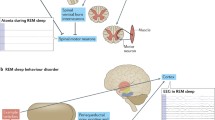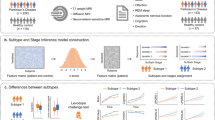Abstract
Purpose
The exact phenoconversion time from isolated rapid eye movement (REM) sleep behavior disorder (iRBD) to synucleinopathies remains unpredictable. This study investigated whole-brain dopaminergic damage pattern (DDP) with disease progression and predicted phenoconversion time in individual patients.
Methods
Age-matched 33 iRBD patients and 20 healthy controls with 11C-CFT-PET scans were enrolled. The patients were followed up 2–10 (6.7 ± 2.0) years. The phenoconversion year was defined as the base year, and every 2 years before conversion was defined as a stage. Support vector machine with leave-one-out cross-validation strategy was used to perform prediction.
Results
Dopaminergic degeneration of iRBD was found to occur about 6 years before conversion and then abnormal brain regions gradually expanded. Using DDP, area under curve (AUC) was 0.879 (90% sensitivity and 88.3% specificity) for predicting conversion in 0–2 years, 0.807 (72.7% sensitivity and 83.3% specificity) in 2–4 years, 0.940 (100% sensitivity and 84.6% specificity) in 4–6 years, and 0.879 (100% sensitivity and 80.7% specificity) over 6 years. In individual patients, predicted stages correlated with whole-brain dopaminergic levels (r = − 0.740, p < 0.001).
Conclusion
Our findings suggest that DDP could accurately predict phenoconversion time of individual iRBD patients, which may help to screen patients for early intervention.



Similar content being viewed by others
Data availability
The data that support the findings of this study are available upon reasonable request.
References
Iranzo A, Santamaria J, Tolosa E. Idiopathic rapid eye movement sleep behaviour disorder: diagnosis, management, and the need for neuroprotective interventions. Lancet Neurol. 2016;15:405–19. https://doi.org/10.1016/S1474-4422(16)00057-0.
Birgit H, Ambra S, Aleksandar V. Idiopathic REM sleep behaviour disorder and neurodegeneration — an update. Nat Rev Neurol. 2017;14(1):40–55. https://doi.org/10.1038/nrneurol.2017.157.
Berg D, Borghammer P, Fereshtehnejad SM, et al. Prodromal Parkinson disease subtypes — key to understanding heterogeneity. Nat Rev Neurol. 2021;17(6):349–61. https://doi.org/10.1038/s41582-021-00486-9.
Schenck C, Boeve B, Mahowald M. Delayed emergence of a parkinsonian disorder or dementia in 81% of older men initially diagnosed with idiopathic rapid eye movement sleep behavior disorder: a 16-year update on a previously reported series. Sleep Med. 2013;14:744–8. https://doi.org/10.1016/j.sleep.2012.10.009.
Postuma RB, Gagnon JF, Bertrand JA, Marchand DG, Montplaisir JY. Parkinson risk in idiopathic REM sleep behavior disorder: preparing for neuroprotective trials. Neurology. 2015;84:1104–13. https://doi.org/10.1212/WNL.0000000000001364.
Iranzo A, Tolosa E, Gelpi E, et al. Neurodegenerative disease status and post-mortem pathology in idiopathic rapid-eye-movement sleep behavior disorder: an observational cohort study. Lancet Neurol. 2013;12:443–53. https://doi.org/10.1016/S1474-4422(13)70056-5.
Cova I, Priori A. Diagnostic biomarkers for Parkinson’s disease at a glance: where are we? J Neural Transm. 2018;125(10):1417–32. https://doi.org/10.1007/s00702-018-1910-4.
Huang T, Wang H, Tang G, et al. The influence of residual Nor-β-CFT in 11C CFT injection on the Parkinson disease diagnosis: a 11C CFT PET study. Clin Nucl Med. 2012;37(8):743–7. https://doi.org/10.1097/RLU.0b013e31824c5fae.
Rosano C, Metti AL, Rosso AL, Studenski S, Bohnen NI. Influence of striatal dopamine, cerebral small vessel disease, and other risk factors on age-related parkinsonian motor signs. J Gerontol A Biol. 2020;75(4):696–701. https://doi.org/10.1093/gerona/glz161.
Ba F, Martin WR. Dopamine transporter imaging as a diagnostic tool for parkinsonism and related disorders in clinical practice. Parkinsonism Relat Disord. 2015;21:87–94. https://doi.org/10.1016/j.parkreldis.2014.11.007.
Rinne OJ, Nurmi E, Ruottinen HM, Bergman J, Eskola O, Solin O. [18F]FDOPA and [18F]CFT are both sensitive PET markers to detect presynaptic dopaminergic hypofunction in early Parkinson’s disease. Synapse. 2001;40(3):193–200.
Albin RL, Koeppe RA, Chervin RD, et al. Decreased striatal dopaminergic innervation in REM sleep behavior disorder. Neurology. 2000;55:1410–2. https://doi.org/10.1212/WNL.55.9.1410.
Iranzo A, Lomena F, Stockner H, et al. Decreased striatal dopamine transporter uptake and substantia nigra hyperechogenicity as risk markers of synucleinopathy in patients with idiopathic rapid-eye-movement sleep behaviour disorder: a prospective study. Lancet Neurol. 2010;9:1070–7. https://doi.org/10.1016/S1474-4422(10)70216-7.
Huang Z, Jiang C, Li L, et al. Correlations between dopaminergic dysfunction and abnormal metabolic network activity in REM sleep behavior disorder. J Cereb Blood Flow Metab. 2020;40(3):552–62. https://doi.org/10.1177/0271678X19828916.
Eisensehr I, Linke R, Noachtar S, et al. Reduced striatal dopamine transporters in idiopathic rapid eye movement sleep behaviour disorder: Comparison with Parkinson’s disease and controls. Brain. 2000;123:1155–60. https://doi.org/10.1093/brain/123.6.1155.
Kim Y, Yoon I, Kim J, et al. The implication of nigrostriatal degeneration in the pathogenesis of REM sleep behavior disorder. Eur J Neurol. 2010;17:487–92. https://doi.org/10.1111/j.1468-1331.2009.02854.x.
Rupprecht S, Walther B, Gudziol H, et al. Clinical markers of early nigrostriatal neurodegeneration in idiopathic rapid eye movement sleep behavior disorder. Sleep Med. 2013;14:1064–7. https://doi.org/10.1016/j.sleep.2013.06.008.
Iranzo A, Valldeoriola F, Lomena F, et al. Serial dopamine transporter imaging of nigrostriatal function in patients with idiopathic rapid-eye-movement sleep behaviour disorder: a prospective study. Lancet Neurol. 2011;10(9):797–805. https://doi.org/10.1016/S1474-4422(11)70152-1.
Iranzo A, Santamaria J, Valldeoriola F, et al. Dopamine transporter imaging deficit predicts early transition to synucleinopathy in idiopathic rapid eye movement sleep behavior disorder. Ann Neurol. 2017;82(3):419–28. https://doi.org/10.1002/ana.25026.
Stokholm MG, Iranzo A, Østergaard K, et al. Extrastriatal monoaminergic dysfunction and enhanced microglial activation in idiopathic rapid eye movement sleep behaviour disorder. Neurobiol Dis. 2018;115:9–16. https://doi.org/10.1016/j.nbd.2018.02.017.
Lewis DA, Melchitzky DS, Sesack SR, Whitehead RE, Auh S, Sampson A. Dopamine transporter immunoreactivity in monkey cerebral cortex: regional, laminar, and ultrastructural localization. J Comp Neurol. 2001;432:119–36. https://doi.org/10.1002/cne.1092.
Son SJ, Kim M, Park H. Imaging analysis of Parkinson’s disease patients using SPECT and tractography. Sci Rep. 2016;6:38070. https://doi.org/10.1038/srep38070.
Sampedro F, Marín-Lahoz J, Martínez-Horta S, et al. Extrastriatal SPECT-DAT uptake correlates with clinical and biological features of de novo Parkinson’s disease. Neurobiol Aging. 2021;97:120–8. https://doi.org/10.1016/j.neurobiolaging.2020.10.016.
Sateia MJ. International classification of sleep disorders-third edition: highlights and modifications. Chest. 2014;146(5):1387–94. https://doi.org/10.1378/chest.14-0970.
Postuma RB, Berg D, Stern M, et al. MDS clinical diagnostic criteria for Parkinson’s disease. Mov Disord. 2015;30:1591–601. https://doi.org/10.1002/mds.26424.
McKeith IG, Dickson DW, Lowe J, et al. Diagnosis and management of dementia with Lewy bodies: third report of the DLB Consortium. Neurology. 2005;65:1863–72. https://doi.org/10.1212/01.wnl.0000187889.17253.b1.
Zhang T, Nie B, Liu H, Shan B. Unified spatial normalization method of brain PET images using adaptive probabilistic brain atlas. Eur J Nucl Med Mol I. 2022;49(9):3073–85. https://doi.org/10.1007/s00259-022-05752-6.
Tzourio-Mazoyer N, Landeau B, Papathanassiou D, et al. Automated anatomical labeling of activations in SPM using a macroscopic anatomical parcellation of the MNI MRI single-subject brain. Neuroimage. 2002;15(1):273–89. https://doi.org/10.1006/nimg.2001.0978.
Sossi V, Holden JE, de la Fuente-Fernandez R, Ruth TJ, Stoessl AJ. Effect of dopamine loss and the metabolite 3-O-eethyl-[18F]fluoro-dopa on the relation between the 18F-fluorodopa tissue input uptake rate constant Kocc and the [18F]fluorodopa plasma input uptake rate constant Ki. J Cereb Blood Flow Metab. 2003;23:301–9. https://doi.org/10.1097/01.WCB.0000050041.22945.3E.
Rolls ET, Huang CC, Lin CP, Feng J, Joliot M. Automated anatomical labelling atlas 3. Neuroimage. 2020;206:116–89. https://doi.org/10.1016/j.neuroimage.2019.116189.
Sjoerds Z, de Wit S, van den Brink W, et al. Behavioral and neuroimaging evidence for overreliance on habit learning in alcohol-dependent patients. Transl Psychiatry. 2013;3(12):e337. https://doi.org/10.1038/tp.2013.107.
Zhao Y, Wu P, Wu J, et al. Decoding the dopamine transporter imaging for the differential diagnosis of parkinsonism using deep learning. Eur J Nucl Med Mol Imaging. 2022;49:2798–811. https://doi.org/10.1007/s00259-022-05804-x.
Wu P, Zhao Y, Wu J, et al. Differential diagnosis of parkinsonism based on deep metabolic imaging indices. J Nucl Med. 2022;63(11):1741–7. https://doi.org/10.2967/jnumed.121.263029.
Jia X, Fan W, Wang Z, et al. Progressive prefrontal cortex dysfunction in Parkinson’s disease with probable REM sleep behavior disorder: a 3-year longitudinal study. Front Aging Neurosci. 2022; 12. https://doi.org/10.3389/fnagi.2021.750767.
Li Y, Kang W, Yang Q, et al. Predictive markers for early conversion of iRBD to neurodegenerative synucleinopathy diseases. Neurology. 2017;88(16):1493–500. https://doi.org/10.1212/WNL.0000000000003838.
Rusz J, Janzen A, Tykalová T, et al. Dysprosody in isolated REM sleep behavior disorder with impaired olfaction but intact nigrostriatal pathway. Mov Disord. 2021;37(3):619–23. https://doi.org/10.1002/mds.28873.
Kraemmer J, Kovacs GG, Perju-Dumbrava L, et al. Correlation of striatal dopamine transporter imaging with post mortem substantia nigra cell counts. Mov Disord. 2014;29:1767–73. https://doi.org/10.1002/mds.25975.
Pavese N, Brooks P. Imaging neurodegeneration in Parkinson’s disease. Biochim Biophys Acta. 2009;1792:722–9. https://doi.org/10.1016/j.bbadis.2008.10.003.
Schenck CH, Bundlie SR, Mahowald MW. Delayed emergence of a parkinsonian disorder in 38% of 29 older men initially diagnosed with idiopathic rapid eye movement sleep behavior disorder. Neurology. 1996;46:388–93. https://doi.org/10.1212/WNL.46.2.388.
Claassen DO, Josephs KA, Ahlskog JE, Silber MH, Tippmann-Peikert M, Boeve BF. REM sleep behavior disorder preceding other aspects of synucleinopathies by up to half a century. Neurology. 2010;75:494–9. https://doi.org/10.1212/WNL.0b013e3181ec7fac.
Chahine LM, Brumm MC, Caspell-Garcia C, et al. Dopamine transporter imaging predicts clinically-defined alpha-synucleinopathy in REM sleep behavior disorder. Ann Clin Transl Neurol. 2021;8(1):201–12. https://doi.org/10.1002/ACN3.51269.
Kim Y, Kim Y, Hwang H, Ma H. REM sleep behavior disorder in early Parkinson’s disease predicts the rapid dopaminergic denervation. Parkinsonism Relat Disord. 2020;80:120–6. https://doi.org/10.1016/j.parkreldis.2020.09.032.
Meles SK, Vadasz D, Renken RJ, et al. FDG PET, dopamine transporter SPECT, and olfaction: combining biomarkers in REM sleep behavior disorder. Mov Disord. 2017;32:1482–6. https://doi.org/10.1002/mds.27094.
Funding
This work was financially supported by the National Natural Science Foundation of China (81401135, 12175268, 12205329, 11975249, 81902282, 81771483, 81361120393), Medical Innovation Research Project of Shanghai Science and Technology Commission (21Y11903300), and Youth Medical Talents-Medical Imaging Practitioner Program by Shanghai Municipal Health Commission and Shanghai Medical and Health Development Foundation (SHWRS(2020)_087).
Author information
Authors and Affiliations
Contributions
B.N and P.W led the project. B.S and H.Y were responsible for the study concept and the design of the study. S.F carried out the neuroimaging data preprocessing and statistical analysis. J.G and Q.X were involved in sample analyses and data interpretation. S.F and J.G wrote the manuscript. Q.X, S.Z, C.Z, B.S, H.Y, B.N, and P.W made substantial contributions to the manuscript and provided critical comments. H.L, J.W, Y.G, T.Z, and S.Z participated in the discussions of the results and the manuscript. All authors had access to the data generated during the study, including the statistical analysis, and agreed with the decision to submit the article for publication.
Corresponding authors
Ethics declarations
Ethics approval
The institutional review board of Huashan Hospital affiliated with Fudan University approved the study (No. KY2013-336).
Consent to participate
Informed consent was obtained from all participants or their assigned surrogate decision-makers.
Conflict of interest
The authors declare no competing interests.
Additional information
Publisher's Note
Springer Nature remains neutral with regard to jurisdictional claims in published maps and institutional affiliations.
Supplementary Information
Below is the link to the electronic supplementary material.
Rights and permissions
Springer Nature or its licensor (e.g. a society or other partner) holds exclusive rights to this article under a publishing agreement with the author(s) or other rightsholder(s); author self-archiving of the accepted manuscript version of this article is solely governed by the terms of such publishing agreement and applicable law.
About this article
Cite this article
Feng, S., Ge, J., Zhao, S. et al. Dopaminergic damage pattern predicts phenoconversion time in isolated rapid eye movement sleep behavior disorder. Eur J Nucl Med Mol Imaging 51, 159–167 (2023). https://doi.org/10.1007/s00259-023-06402-1
Received:
Accepted:
Published:
Issue Date:
DOI: https://doi.org/10.1007/s00259-023-06402-1




